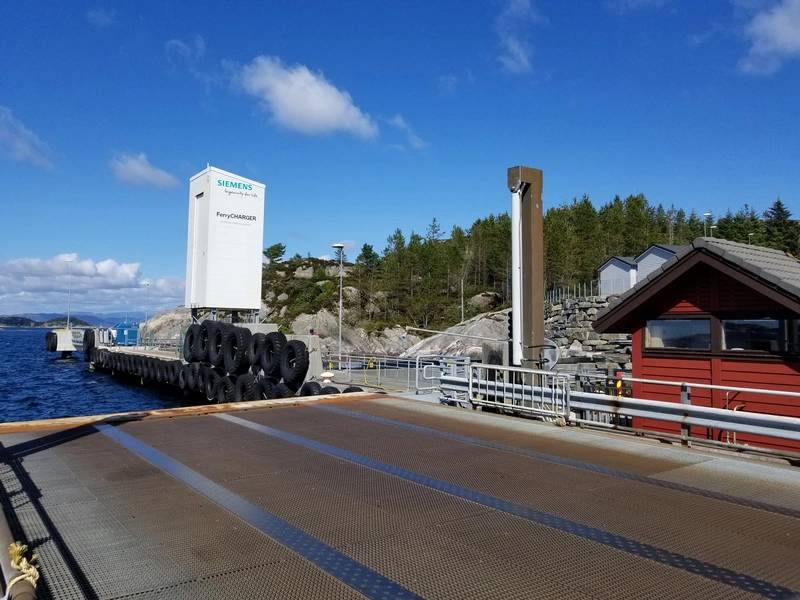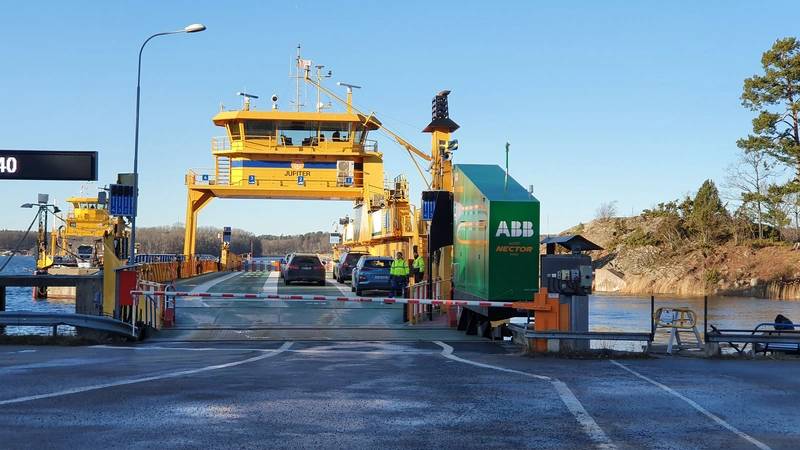Rapid Charging Systems: Current Technology for the Future of Ferries
As the devotion to more sustainable shipping expands and regulations become more stringent, the demand for lower emissions operations continues to increase. As a result, the marine industry is confronted with the challenge of large-scale electrification as an alternative energy solution.
For electric ferries, one developing technology is Rapid Charging Systems (RCS), which transfer electrical power from the shore to a vessel at a high rate. These charging systems establish a ship-to-shore connection quickly, providing a power transfer solution for vessels with short docking periods.
As the United States maritime industry continues to adapt to more sustainable powering and propulsion technologies and begins to incorporate energy storage on a larger scale, there are existing active RCS options to consider. Notably, Scandinavia has a significant quantity of plug-in ferries in service that operate with RCS.
The most significant challenge associated with introducing RCS is the ship's motions relative to the pier. The system must span a gap to the vessel and maintain a safe electrical connection without interfering with vessel operations. Subsequently, most existing systems utilize positive restraint to minimize vessel motions. Developing such systems often requires substantial installations or modifications of shore-side infrastructure. Some plug-in ferries in Scandinavia have actually gone into service before their corresponding final charging systems could be installed. A temporary mechanical testing stage can prove out system functionality, which delays electrical infrastructure costs until the planned solution is verified for a final installation.
Elliott Bay Design Group (EBDG) is working on the development of plug-in vessels with several clients, including Casco Bay Lines, Washington State Ferries, and Water Emergency Transportation Authority. These ferries will be some of the first plug-in vessels in North America, supporting a more sustainable future for shipping. With a wide array of continuously developing technologies, it's important for EBDG to provide unbiased engineering analysis that accurately characterizes the available options for vessel owners and operators.
Some of the key factors that drive the varying system designs are vessel and dock configurations, automation, power requirements, schedule, and route. The types of RCS can be loosely categorized as follows:
- Mounted on Auxiliary Side Dock vs Loading Ramp
- Vertical (Hook) vs Horizontal (Extension) vs Davit (Crane)
- Automated vs Manual
 Stemmann-Technik side FerryCHARGER. Image courtesy Will Ayers, EBDG
Stemmann-Technik side FerryCHARGER. Image courtesy Will Ayers, EBDG
Making a safe and secure connection between vessel and shoreside components is of primary importance. However, a fast connection is often desired in order to maximize charging duration without affecting the vessel schedule. Vessel motion, including tidal fluctuation, is one challenge to consider that impacts the safety and speed of connection.
Most existing RCS utilize positive restraint mooring, typically an automated mooring device, to minimize vessel motions while at the dock. While automated mooring combined with RCS can make secure connections quickly, such systems that connect to the side of a vessel are not well suited to an end-docking configuration and could require extensive modifications to infrastructure.
Bow charging, an alternative system configuration, can either be mounted on a stationary structure or on the vehicle ramp. These RCS may not require positive restraint and could reduce the magnitude of necessary infrastructure modifications.
Another possible solution is a davit RCS. The davit offers a large range of connection points through a rotating arm that can adjust vertical and horizontal position, potentially simplifying mooring arrangements. Although a manual davit may reduce the duration of charge by increasing the connection time, this comparatively simple solution could provide sufficient power to a vessel with low power requirements.
Several active and developing RCS technologies are outlined below.
- Cavotec offers a variety of manual or automatic charging technologies. The horizontal automated plug-in system (APS) is an autonomous solution for bow charging, which has installations across Norway. Another system with existing active installations is the APS tower, a semi-autonomous vertical (hook) solution with vessel infrastructure installed near midship. The APS can establish quick connections, particularly when paired with the Cavotec automated mooring system, MoorMaster.
- The CharIN Megawatt Charging System (MCS) is a plug-in solution still under development, which has a charging capacity up to 3 MW. The plug was designed as a charging solution for the trucking industry with marine applications. By charging with multiple plugs, a CharIN MCS system could provide higher levels of power.
- 3mar (Mobimar) offers a ramp-mounted autonomous bow charging system, NECTOR, that can establish a rapid connection to the vessel, easily activated via push button from the bridge. An active NECTOR installation serves the all-electric ferry ELLEN in Denmark.
- Shore-Link has developed an autonomous ramp-mounted charging system with a charging capacity up to 5 MW. The CONNECTOR for E-ferry establishes quick connections and automatically compensates for vessel motions through the horizontally extending arm on a vertically traveling platform.
- Stemmann-Technik offers autonomous horizontal charging arms, which have active installations across Norway. Another system, the FerryCHARGER, is an autonomous bow charging davit that can be mounted alongside a vehicle loading ramp.
- Zinus offers a manual or autonomous system, consisting of vertical plugs hanging from an extendible overhead arm.
The existing and transforming charging technology reinforces the growing commitment to a more sustainable shipping future. Although vessel electrification includes challenging elements, it also offers an opportunity to contribute to the evolution of ship powering and propulsion.









